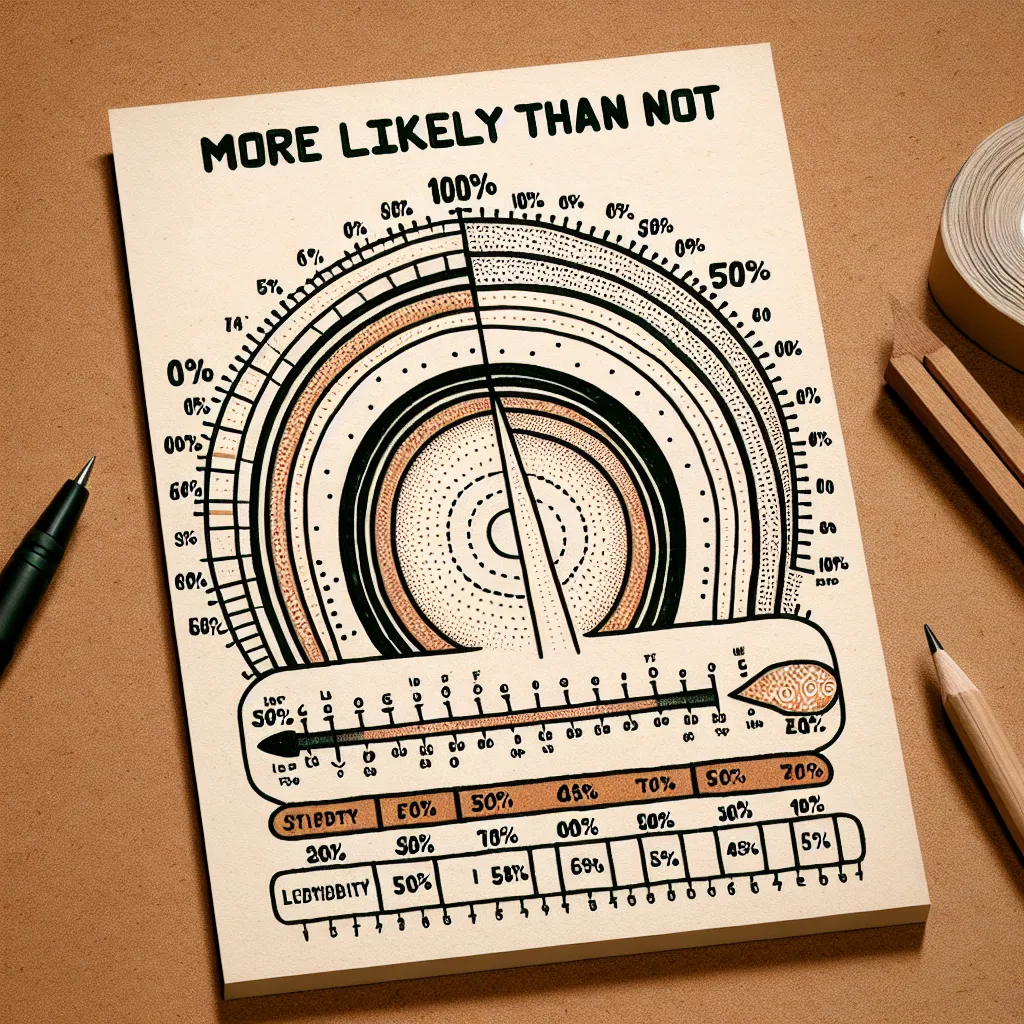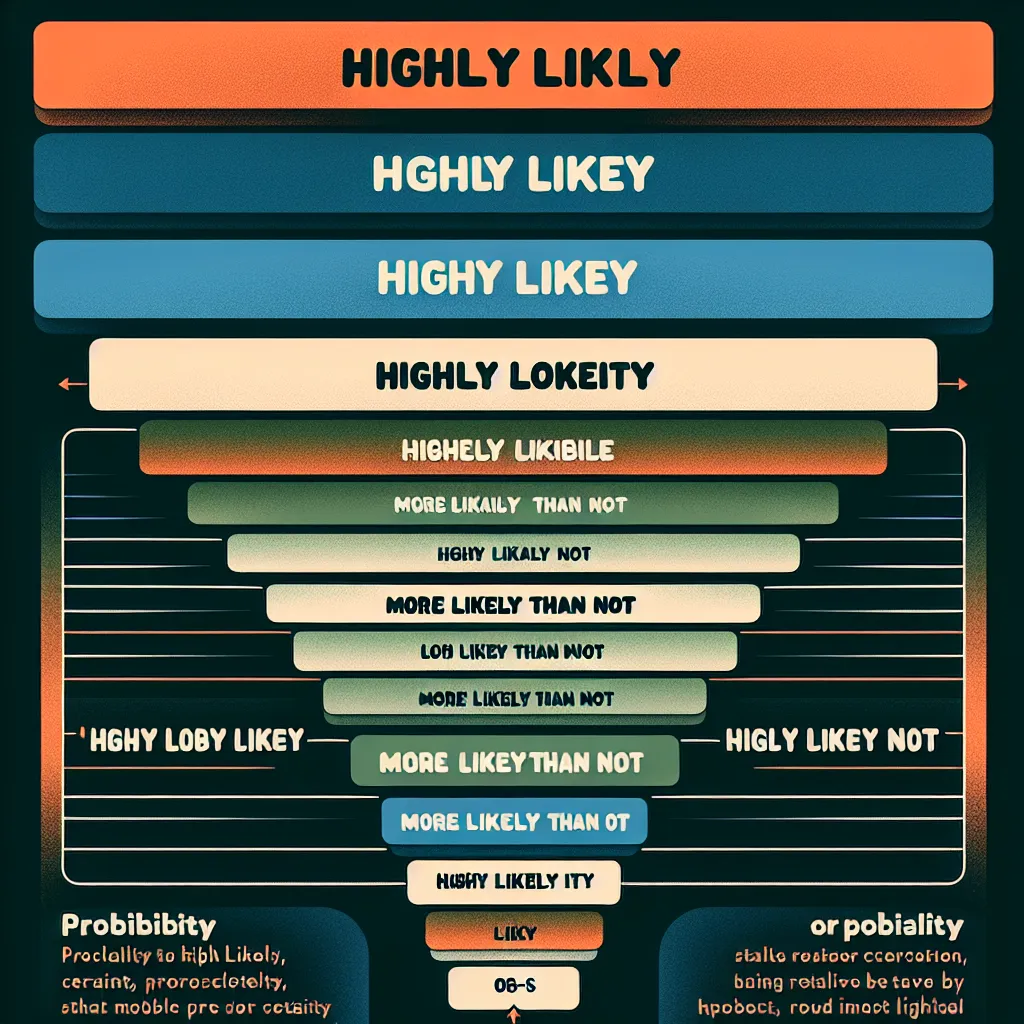The phrase “more likely than not” is a powerful expression used to indicate probability in English. Understanding how to use this phrase correctly can significantly enhance your IELTS performance, particularly in the Writing and Speaking sections. Let’s explore its meaning, usage, and how to incorporate it effectively in your IELTS responses.
Table Of Contents
Understanding “More Likely Than Not”
“More likely than not” is an idiomatic expression used to indicate that something has a higher probability of occurring or being true than not occurring or being false. It suggests a likelihood of more than 50%, but without absolute certainty.
 Probability Scale
Probability Scale
Usage in Context
This phrase is often used in formal or academic contexts, making it particularly suitable for IELTS tasks. Here are some examples of how it can be used:
- “Based on current economic trends, it is more likely than not that interest rates will rise next year.”
- “Given the weather forecast, it is more likely than not that our outdoor event will be postponed.”
- “Considering the evidence presented, it is more likely than not that the defendant is guilty.”
Incorporating “More Likely Than Not” in IELTS Writing
Using sophisticated probability expressions like “more likely than not” can elevate your writing and demonstrate a high level of language proficiency. Here’s how you can incorporate it into different parts of the IELTS Writing test:
Task 1 (Academic)
When describing trends or making predictions based on data:
“According to the graph, it is more likely than not that smartphone usage will continue to increase over the next five years.”
Task 2
In argumentative or discursive essays:
“While there are arguments on both sides, it is more likely than not that the benefits of renewable energy outweigh the initial costs of implementation.”
Enhancing IELTS Speaking Responses
Using “more likely than not” in your speaking responses can showcase your vocabulary range and ability to express nuanced opinions. Here are some examples:
-
Part 1 (Interview):
Question: “Do you think you’ll change your job in the future?”
Answer: “Well, given my current career aspirations, it’s more likely than not that I’ll explore new job opportunities in the next few years.” -
Part 2 (Cue Card):
Topic: Describe a decision you made that you’re proud of.
“…After careful consideration, I decided it was more likely than not that pursuing further education would benefit my career in the long run…” -
Part 3 (Discussion):
Question: “How do you think technology will impact education in the future?”
Answer: “Based on current trends, it’s more likely than not that virtual reality will play a significant role in classroom learning experiences within the next decade.”
Alternative Expressions and Comparisons
To further enhance your IELTS performance, consider using a variety of probability expressions. Here’s a comparison of different phrases and their approximate levels of certainty:
- Certainly (100%)
- Very likely (80-90%)
- More likely than not (51-70%)
- Possibly (40-60%)
- Unlikely (10-30%)
- Certainly not (0%)
Using these expressions appropriately can help you achieve higher band scores by demonstrating a nuanced understanding of probability and a rich vocabulary.
 Probability Expressions Comparison
Probability Expressions Comparison
Common Mistakes to Avoid
When using “more likely than not” in IELTS, be aware of these common errors:
-
Overuse: While it’s a useful phrase, using it too frequently can make your speech or writing sound repetitive.
Incorrect: “It’s more likely than not that I’ll go to the beach, and it’s more likely than not that I’ll swim.”
Better: “It’s more likely than not that I’ll go to the beach, and if I do, I’ll probably swim.” -
Incorrect word order:
Incorrect: “It is likely more than not that the project will be completed on time.”
Correct: “It is more likely than not that the project will be completed on time.” -
Using it for absolute certainties:
Incorrect: “It is more likely than not that the sun will rise tomorrow.”
Better: “It is certain that the sun will rise tomorrow.” -
Misusing with specific percentages:
Incorrect: “It is more likely than not, about 90%, that it will rain today.”
Better: “It is very likely, about 90% probable, that it will rain today.”
Conclusion
Mastering the use of “more likely than not” and similar probability expressions can significantly enhance your IELTS performance. By incorporating this phrase appropriately in your Writing and Speaking responses, you demonstrate a sophisticated command of English and the ability to express nuanced opinions. Remember to practice using this expression in context and vary your language with alternative phrases to achieve the best results in your IELTS test.
To further improve your skills, try incorporating “more likely than not” in practice essays on topics such as environmental issues, technological advancements, or social changes. This will help you become more comfortable with the phrase and use it naturally during the actual test.


